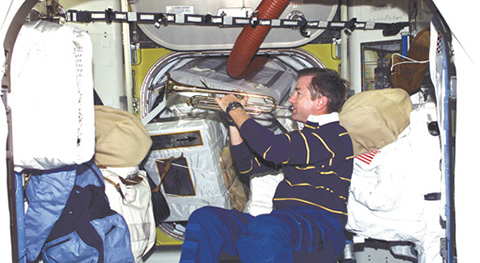Make a donation to the museum
Commemorating 9/11 on the International Space Station
- Stories from the Museum
- Memorializing 9/11
NASA astronaut Frank L. Culbertson, Jr., was the only American not on the planet on September 11, 2001. He was aboard the International Space Station (ISS), orbiting the Earth, when he learned about the attacks. As the spacecraft passed over the east coast of the United States, Culbertson grabbed a video camera. Even at a distance of more than 200 miles, he could see smoke billowing over New York City. When he told his Russian crewmates what had happened, they were outraged and sympathetic, joining him at the space station’s windows as they again passed over New York and Washington, D.C.
The next day, Culbertson learned that the pilot of the plane that hijackers had crashed into the Pentagon was his U.S. Naval Academy classmate Captain Charles F. Burlingame III. To honor his friend, a few days later Culbertson took out the trumpet he had brought aboard the ISS and recorded himself playing “Taps,” a tune traditionally associated with military funerals. This recording from space would be broadcast at the U.S. Navy vs. Boston College football game on September 22, 2001, just two days after a memorial service was held for Captain Burlingame in the Naval Academy Chapel at Annapolis, Maryland.
Video
U.S. Navy SEAL and NASA astronaut Christopher Cassidy found another way to commemorate 9/11 on the ISS. Cassidy had been part of a team that deployed to Afghanistan two weeks after 9/11, and served as a Ground Assault Force Commander during Operation Enduring Freedom.
In 2020, Cassidy brought some of Chandler Raymond Keller’s ashes and other possessions aboard the ISS during Expedition 63. Keller, a passenger on hijacked Flight 77 who was killed in the attack on the Pentagon, had been interested in outer space since childhood. Growing up, Keller showed an aptitude for mathematics and engineering and enjoyed building and launching model rockets in his backyard. He ultimately became a propulsion engineer and project manager for Boeing Satellite Systems, collaborating with the U.S. Department of Defense on a satellite project designed to monitor terrorist activity.
